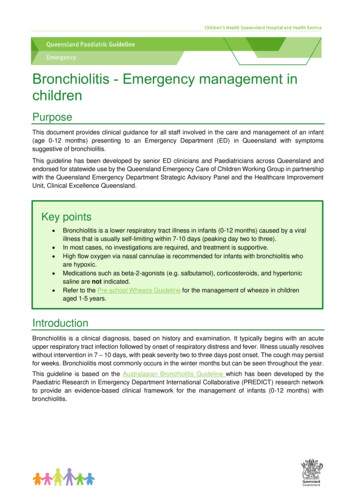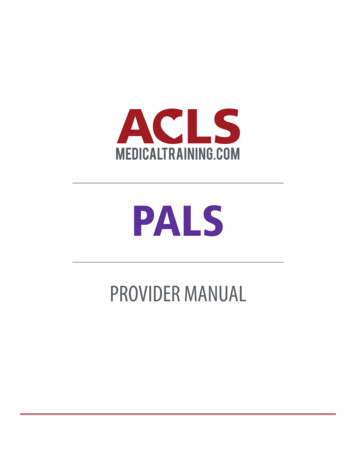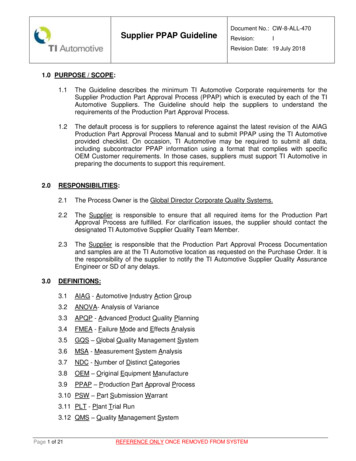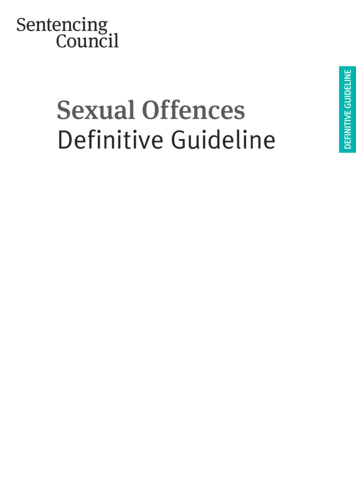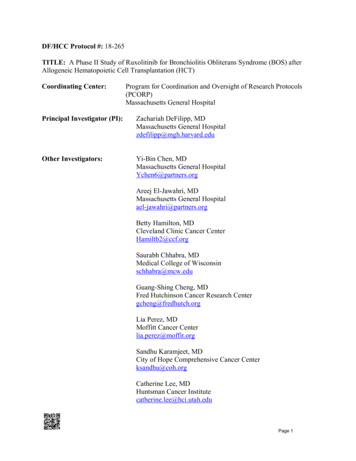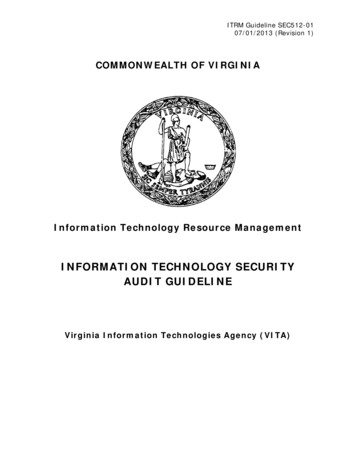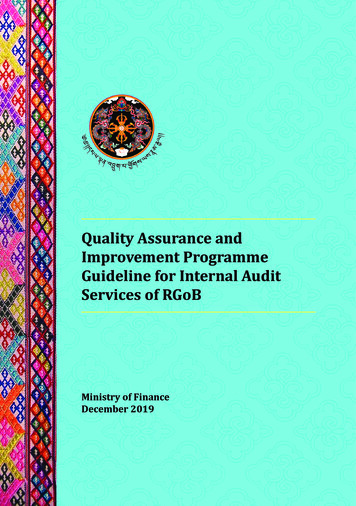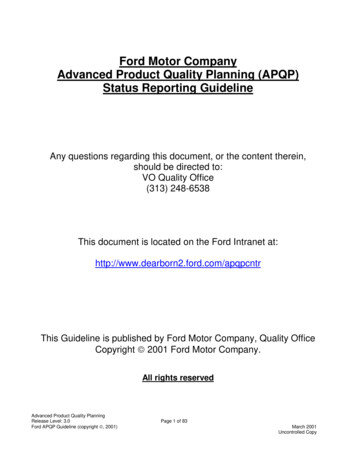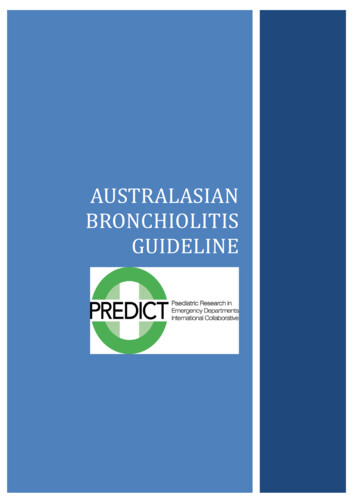
Transcription
AUSTRALASIANBRONCHIOLITISGUIDELINE
Table of ContentsAcknowledgments . 4Australasian Bronchiolitis Guideline . 5Purpose/Aim . 5Diagnosis . 5Features . 5Risk factors for more serious illness . 5Initial Assessment . 5Initial Management. 6Investigations . 7Management. 7Ongoing management . 8Discharge planning and community-based management . 8Education (parent/care-giver) . 8Safety initiatives . 8Clinical Recommendations. 9Diagnosis . 9Clinical Recommendations. 10Management. 10Methodology. 12PICOt Questions . 14Clinical Recommendations Evidence Summaries . 16Evidence Tables. 28Question 1.GRADE Evidence Summary . 28Question 1.NHMRC Evidence Summary . 29Question 2.GRADE Evidence Summary . 31Question 2.NHMRC Evidence Summary . 32Question 3.GRADE Evidence Summary . 34Question 3.NHMRC Evidence Summary . 35Question 4.GRADE Evidence Summary . 37Question 4.NHMRC Evidence Summary . 38Question 5.GRADE Evidence Summary . 40Question 5.NHMRC Evidence Summary . 41Question 6.GRADE Evidence Summary . 43Question 6.NHMRC Evidence Summary . 44Australasian Bronchiolitis Guideline 31 August 20161
Question 7.GRADE Evidence Summary . 46Question 7.NHMRC Evidence Summary . 47Question 8a. i)GRADE Evidence Summary . 49Question 8a. i)NHMRC Evidence Summary. 50Question 8a. ii)GRADE Evidence Summary . 52Question 8a. ii)NHMRC Evidence Summary. 53Question 8b. i)GRADE Evidence Summary . 55Question 8b. i)NHMRC Evidence Summary . 56Question 8b. ii)GRADE Evidence Summary . 58Question 8b. ii)NHMRC Evidence Summary . 59Question 9.GRADE Evidence Summary . 61Question 9.NHMRC Evidence Summary . 62Question 10.GRADE Evidence Summary . 64Question 10.NHMRC Evidence Summary. 65Question 11a.GRADE Evidence Summary . 67Question 11a.NHMRC Evidence Summary. 68Question 11b.GRADE Evidence Summary . 70Question 11b.NHMRC Evidence Summary . 71Question 11c.GRADE Evidence Summary . 73Question 11c.NHMRC Evidence Summary . 74Question 12a.GRADE Evidence Summary . 76Question 12a.NHMRC Evidence Summary. 77Question 12b.GRADE Evidence Summary . 79Question 12b.NHMRC Evidence Summary . 80Question 13.GRADE Evidence Summary . 82Question 13.NHMRC Evidence Summary. 83Question 14.GRADE Evidence Summary . 85Question 14.NHMRC Evidence Summary. 86Question 15.GRADE Evidence Summary . 88Question 15.NHMRC Evidence Summary. 89Question 16a.GRADE Evidence Summary . 91Question 16a.NHMRC Evidence Summary. 91Question 16b.GRADE Evidence Summary . 94Question 16b.NHMRC Evidence Summary . 94Question 17.GRADE Evidence Summary . 97Question17.NHMRC Evidence Summary . 98Australasian Bronchiolitis Guideline 31 August 20162
Question 18.GRADE Evidence Summary . 100Question 18.NHMRC Evidence Summary. 101Question 19.GRADE Evidence Summary . 103Question 19.NHMRC Evidence Summary. 104Question 20a.GRADE Evidence Summary . 106Question 20a.NHMRC Evidence Summary. 107Question 20b.GRADE Evidence Summary . 109Question 20b.NHMRC Evidence Summary . 110Question 20c.GRADE Evidence Summary . 112Question 20c.NHMRC Evidence Summary . 112Question 21a.GRADE Evidence Summary . 115Question 21a.NHMRC Evidence Summary. 116Question 21b.GRADE Evidence Summary . 118Question 21b.NHMRC Evidence Summary . 119Question 21c.GRADE Evidence Summary . 121Question 21c.NHMRC Evidence Summary . 122Question 22.GRADE Evidence Summary . 124Question 22.NHMRC Evidence Summary. 125Research Recommendations . 127References . 130Disclaimer. 142Australasian Bronchiolitis Guideline 31 August 20163
AcknowledgmentsThe Australasian Bronchiolitis Guideline have been developed by the Paediatric Research inEmergency Departments International Collaborative (PREDICT) research network and weacknowledge the generous financial assistance provided by the National Health and MedicalResearch Council (Grant ID 1058560).A Guideline Advisory Group was initially established from PREDICT and convened a multidisciplinaryGuideline Development Committee with expert knowledge and skills within the fields of Emergencyand Paediatric Medicine. This multidisciplinary Development Committee complement the skills andknowledge of the Guideline Advisory Group. This ensured stakeholder engagement andrepresentation from specific specialty areas to ensure broad relevance of the guideline.Guideline Advisory GroupAssociate Professor Meredith BorlandAssociate Professor Elizabeth CotterellDr Stuart DalzielAssociate Professor Edward OakleyMs Sharon O’BrienMultidisciplinary Guideline Development CommitteeDr David ArmstrongAssociate Professor Franz BablDr Paul BauertDr Christine BrabynDr Lydia GarsideMs Libby HaskellDr David LevittMs Nicola McKayDr Jocelyn NeutzeAssociate Professor Andreas SchiblerDr Kam SinnDr Janine SpencerMs Helen StevensDr David ThomasDr Michael ZhangPREDICT would like to acknowledge the input and feedback provided in the consultation phase bystakeholders to ensure relevance of the final guideline to the Australasian emergency and paediatricward setting. Formal feedback was received from: Australasian College for Emergency Medicine,The Australian Paediatric Society, The Royal Australasian College of Physicians, South Island AllianceChild Health Service, Children’s Healthcare Australasia, Australian College of Emergency Nursing Ltd,The Australian College of Children and Young People’s Nurses, College of Child and Youth NursesNew Zealand, College of Emergency Nurses New Zealand, Family Advisory Committee RoyalChildren’s Hospital Melbourne, New South Wales Office of Kids and Families, New South WalesPaediatric Clinical Nurse Consultant Group, Paediatric Department Christchurch Hospital, PaediatricRespiratory Department Starship Children’s Health, Royal New Zealand College of Urgent Care,Professor Innes Asher, Associate Professor Simon Craig, Dr Joshua Osowicki, Dr Arjun Rao, AssociateProfessor Mike Starr and Dr Emma Tavendar.PREDICT would also like to acknowledge the support and assistance provided by Ms CatherineWilson, PREDICT Research Network Co-ordinator.Australasian Bronchiolitis Guideline 31 August 20164
Australasian Bronchiolitis GuidelinePurpose/AimThis guideline has been developed to provide an evidence based clinical framework for themanagement of infants (0-12 months) with bronchiolitis treated in Australasian emergencydepartments (EDs) or general paediatric wards. Application of these guidelines for children over 12months may be relevant but there is less diagnostic certainty in the 12-24 month age group.(All references to age within this Guideline refer to chronological age unless stated otherwise.)DiagnosisViral bronchiolitis is a clinical diagnosis, based on typical history and examination. Peak severity isusually at around day two to three of the illness with resolution over 7-10 days. The cough may persistfor weeks. Bronchiolitis most commonly occurs in the winter months, but can be seen all year round.FeaturesBronchiolitis typically begins with an acute upper respiratory tract infection followed by onset ofrespiratory distress and fever and one or more of: Cough Tachypnoea Retractions Widespread crackles or wheezeBronchiolitis is usually self-limiting, often requiring no treatment or interventions.Risk factors for more serious illness Gestational age less than 37 weeksChronological age at presentation less than 10 weeksPost natal exposure to cigarette smokeBreast fed for less than two monthsFailure to thriveChronic lung diseaseCongenital heart diseaseChronic neurological conditionsIndigenous ethnicityInfants with any of these risk factors are more likely to deteriorate rapidly and require escalation ofcare. Consider hospital admission even if presenting early in illness with mild symptoms.Initial AssessmentThis table is meant to provide guidance in order to stratify severity. The more symptoms the infant has in themod-severe categories, the more likely they are to develop severe rmittentirritabilityRespiratory RateNormal – mildtachypnoeaIncreased respiratoryrateUse of accessorymusclesNil to mild chest wallretractionModerate chest wallretractionsTracheal tugNasal flaringOxygen saturation /oxygen requirementO2 saturations greaterthan 92%(in room air)O2 saturations 90 - 92%(in room air)Apnoeic episodesNoneMay have brief apnoeaFeedingNormalMay have difficulty withfeeding or reducedfeedingIncreasing irritabilityand/or lethargyFatigueMarked increase ordecrease in respiratoryrateMarked chest wallretractionsMarked tracheal tugMarked nasal flaringO2 saturations lessthan 90%(in room air)Hypoxemia, may notbe corrected by O2May have increasinglyfrequent or prolongedapnoeaReluctant or unable tofeedAustralasian Bronchiolitis Guideline 31 August 20165
Initial ManagementThe main treatment of bronchiolitis is supportive. This involves ensuring appropriate oxygenation andfluid intake.MildModerateSevereLikelihood ofSuitable for discharge Likely admission, mayRequires admissionAdmissionbe able to beand consider need forConsider risk factorsdischargedtransfer to anafter a period ofappropriate children’sobservationfacility/PICUManagement shouldbe discussed with alocal senior physicianObservationsVital signs (respiratoryrate, heart rate, O2saturations, temperature)Hydration/NutritionOxygen saturation /oxygen requirementAdequate assessmentin ED prior todischarge (minimumof two recordedmeasurements orevery four hours asper local hospitalguidelines and EWT)Small frequent feedsNil requirementRespiratory SupportHourly - dependenton condition (as perlocal hospitalguidelines and EWT)If not feedingadequately (less than50% over 12 hours),administer NG or IVhydrationAdminister O2 tomaintain saturationsgreater than or equalto 92%Consider HFNC if atrial of NPO2 isineffectiveDecision to admitshould be supportedby clinicalassessment, socialand geographicalfactors and phase ofillnessDisposition/EscalationConsider furthermedical review if earlyin the illness and anyrisk factors arepresent or if childdevelops increasingseverity afterdischargeParental EducationProvide advice on theexpected course ofillness and when toreturn (worseningsymptoms andinability to feedadequately)Provide advice on theexpected course ofillness and when toreturn (worseningsymptoms andinability to feedadequately)Provide ParentInformation SheetProvide ParentInformation SheetAustralasian Bronchiolitis Guideline 31 August 2016Threshold for referral isdetermined by localescalation policies butshould be earlyHourly with continuouscardiorespiratory(including oximetry)monitoring and closenursing observation dependent on condition(as per local hospitalguidelines and EWT)If not feedingadequately (less than50% over 12 hours), orunable to feed,administer NG or IVhydrationAdminister O2 tomaintain saturationsgreater than or equal to92%Consider HFNC orCPAPConsider escalation ifseverity does notimprove.Consider ICU review/admission or transfer tolocal centre withpaediatric HDU/ICUcapacity if:- Severity does notimprove- Persistentdesaturations- Significant orrecurrent apnoea’sassociated withdesaturationsProvide advice on theexpected course ofillnessProvide ParentInformation Sheet6
PICU paediatric intensive care unit, EWT early warning tool, NG Nasogastric, IV Intravenous,NPO2 Nasal Prong Oxygen, HFNC heated humidified high flow oxygen/air via nasal cannulae,CPAP continuous positive airway pressure, HDU high dependency unit.InvestigationsIn most infants presenting to hospital and/or hospitalised with bronchiolitis, no investigations arerequired.Chest x-ray (CXR)- Is not routinely indicated in infants presenting with bronchiolitis and may lead tounnecessary treatment with antibiotics with subsequent risk of adverse eventsBlood tests (including full blood count (FBC), blood cultures)Have no role in managementVirological testing (nasopharyngeal swab or aspirate)- Has no role in management of individual patientsUrine microscopy and culture- May be considered to identify urinary tract infection if a temperature over 38 degrees inan infant less than two months of age with bronchiolitis.ManagementRespiratory Support- Oxygen therapy should be instituted when oxygen saturations are persistently less than92%- It is appreciated that infants with bronchiolitis will have brief episodes of mild/moderatedesaturations to levels less than 92%. These brief desaturations are not a reason tocommence oxygen therapy.- Oxygen should be discontinued when oxygen saturations are persistently greater than orequal to 92%.- Heated humidified high flow oxygen/air via nasal cannulae (HFNC) can beconsidered in the presence of hypoxia (oxygen saturation less than 92%) and moderateto severe recessions. Its use in infants without hypoxia should be limited to therandomised controlled trial (RCT) setting onlyMonitoring- Observations as per local hospital guidelines and Early Warning Tools (EWTs)- Continuous oximetry should not be routinely used to dictate medical managementunless disease is severeHydration/Nutrition- When non-oral hydration is required either intravenous (IV) or nasogastric (NG) hydrationare appropriate- If IV fluid is used it should be isotonic (0.9% Sodium Chloride with Glucose or similar)- The ideal volume of IV or NG fluids required to maintain hydration remains unknown;between 60% to 100% of maintenance fluid is an appropriate volume to initiateMedication- Beta 2 agonists – Do not administer beta 2 agonists (including those with a personal orfamily history of atopy)- Corticosteroids – Do not administer systemic or local glucocorticoids (nebulised, oral,intramuscular (IM) or IV)- Adrenaline – Do not administer adrenaline (nebulised, IM or IV) except in peri-arrest orarrest situation.- Hypertonic Saline – Do not administer nebulised hypertonic saline- Antibiotics – Including Azithromycin are not indicated in bronchiolitis- Antivirals - Are not indicatedAustralasian Bronchiolitis Guideline 31 August 20167
Nasal Suction- Nasal suction is not routinely recommended. Superficial nasal suction may beconsidered in those with moderate disease to assist feeding- Nasal saline drops may be considered at time of feedingChest PhysiotherapyIs not indicatedOngoing management-HFNC or Nasal CPAP therapy may be considered in the appropriate ward settingDischarge planning and community-based management--Infants can be discharged when oxygen saturations are greater than or equal to 92% andfeeding is adequateInfants younger than 8 weeks of age are at an increased risk of representationDischarge on home oxygen can be considered after a period of observation in selectedinfants as per local policies, if appropriate community short term oxygen therapy isavailable.Follow up and review as per local practiceEducation (parent/care-giver)-A Bronchiolitis Parent Information Sheet should be providedParents should be educated about the illness, the expected progression and when andwhere to seek further medical careSafety initiatives-Use simple infection control practices such as hand washingCohorting of infants (based on virological testing) has not been shown to improveoutcomesAustralasian Bronchiolitis Guideline 31 August 20168
Clinical RecommendationsDiagnosis1. Infants can be diagnosed with bronchiolitis if they have an upper respiratory tractinfection followed by onset of respiratory distress with fever, and one or more of: cough,tachypnoea, retractions and diffuse crackles or wheeze on auscultation.(NHMRC: C, GRADE: Weak)2. Clinicians should consider as risk factors for more serious illness: gestational age lessthan 37 weeks; chronological age at presentation less than 10 weeks; exposure tocigarette smoke; breast feeding for less than two months; failure to thrive; having chroniclung disease; having chronic heart and/or chronic neurological conditions; beingIndigenous ethnicity, and should take these into account when managing infants withbronchiolitis.(NHMRC: C, GRADE: Conditional)3. Routine CXR is not recommended as it does not improve management in infantspresenting with simple bronchiolitis, and may lead to treatments of no benefit.(NHMRC: D, GRADE: Conditional)4. There is no role for blood tests in managing infants presenting to hospital andhospitalised with bronchiolitis. Routine bacteriological testing of blood and urine is notrecommended.(NHMRC: D, GRADE: Conditional)In infants less than two months of age presenting to hospital or hospitalised withbronchiolitis with a temperature over 38 degrees, there is a low risk of urinary tractinfection (UTI). If clinical uncertainty exists clinicians may consider collecting aurine sample for microscopy, culture and sensitivity looking for the concurrent presence ofUTI.5. In infants with bronchiolitis, routine use of viral testing is not recommended for anyclinically relevant end-points, including cohorting of bronchiolitis patients.(NHMRC: C, GRADE: Conditional)Australasian Bronchiolitis Guideline 31 August 20169
Clinical RecommendationsManagement6. For infants presenting to hospital or hospitalised with bronchiolitis, there is insufficientevidence to recommend the use of a scoring system to predict need for admission orhospital length of stay.(NHMRC: D, GRADE: Weak)7. Oxygen saturations, adequacy of feeding, age (infants younger than eight weeks), andlack of social support should be considered at the time of discharge as a risk forrepresentation. There is insufficient evidence to recommend absolute discharge criteria forinfants attending the ED, or hospitalised with bronchiolitis(NHMRC: Practice Point, GRADE: Weak)8a. Do not administer beta 2 agonists to infants, less than or equal to 12 months of age,presenting to hospital or hospitalised with bronchiolitis.(NHMRC: A, GRADE: Strong)8b. Do not administer beta 2 agonists to infants, less than or equal to 12 months of age,presenting to hospital or hospitalised with bronchiolitis, with a personal or family history ofatopy.(NHMRC: D, GRADE: Weak)9. Do not administer adrenaline/epinephrine to infants presenting to hospital or hospitalisedwith bronchiolitis.(NHMRC: B, GRADE: Strong)10. Do not administer nebulised hypertonic saline in infants presenting to hospital orhospitalised with bronchiolitis.(NHMRC: D, GRADE: Conditional)11a. Do not administer systemic or local glucocorticoids to infants presenting to hospital orhospitalised with bronchiolitis.(NHMRC: B, GRADE: Strong)11b. Do not administer systemic or local glucocorticoids to infants presenting to hospital orhospitalised with bronchiolitis, with a positive response to beta 2 agonists.(NHMRC: D, GRADE: Weak)11c. Do not administer a combination of systemic or local glucocorticoids andadrenaline/epinephrine to infants presenting to hospital or hospitalised with bronchiolitis.(NHMRC: D, GRADE: Weak)12a. Consider the use of supplemental oxygen in the treatment of hypoxic (oxygensaturations less than 92%) infants with bronchiolitis.(NHMRC: C, GRADE: Conditional)12b. In uncomplicated bronchiolitis oxygen supplementation should be commenced if theoxygen saturation level is sustained at a level less than 92%. At oxygen saturation levels of92% or greater, oxygen therapy should be discontinued.(NHMRC: C, GRADE: Conditional)13. Routine use of continuous pulse oximetry is not required for medical management ofnon-hypoxic (saturations greater than or equal to 92%) infants not receiving oxygen, orstable infants receiving oxygen.(NHMRC: C, GRADE: Conditional)Australasian Bronchiolitis Guideline 31 August 201610
14. High Flow Nasal Cannulae Oxygen (HFNC) in bronchiolitis can be considered in theinpatient setting on infants with bronchiolitis with hypoxia (oxygen saturations less than92%). Its use in children without hypoxia should be limited to the RCT setting only.(NHMRC: C, GRADE: Conditional)15. Chest physiotherapy is not recommended for routine use in infants with bronchiolitis.(NHMRC: B, GRADE: Strong)16a. Nasal suction is not recommended as routine practice in the management of infantswith bronchiolitis. Superficial nasal suction may be considered in those with moderatedisease to assist feeding.(NHMRC: D, GRADE: Conditional)16b. Deep nasal suction for the management of bronchiolitis is not recommended.(NHMRC: D, GRADE: Conditional)17. Routine nasal saline drops are not recommended. Trial of intermittent saline drops maybe considered at time of feeding.(NHMRC: Practice Point, GRADE: Weak)18. Nasal CPAP therapy for infants with bronchiolitis may be considered for themanagement of infants.(NHMRC: C, GRADE: Conditional)19. After a period of observation, infants at low risk for severe bronchiolitis can beconsidered for discharge on home oxygen as part of an organised ‘Home Oxygen Program’which has clear ‘Return to Hospital’ advice.(NHMRC: C, GRADE: Conditional)20a. Do not use antibiotics to treat infants with bronchiolitis.(NHMRC: B, GRADE: Conditional)20b. Do not use azithromycin for treatment of infants admitted to hospital with bronchiolitis.(NHMRC: B, GRADE: Conditional)20c. Do not use azithromycin for treatment of infants admitted to hospital with bronchiolitiswho are at risk of developing bronchiectasis.(NHMRC: C, GRADE: Conditional)21a. Supplemental hydration is recommended for infants who cannot maintain hydrationorally.(NHMRC: Practice Point, GRADE: Weak)21b. Both NG and IV routes are acceptable means for non-oral hydration in infants admittedto hospital with bronchiolitis.(NHMRC: B, GRADE: Strong)21c. There is insufficient evidence to recommend a specific proportion of maintenance fluid.There is a risk of fluid overload therefore judicious and vigilant use of hydration fluid is andregular clinical review is recommended. Isotonic fluid is recommended.(NHMRC: Practice Point, GRADE: Weak)22. Hand hygiene is the most effective intervention to reduce hospital acquired infectionsand is recommended. There is inadequate evidence for benefits in cohorting infants withbronchiolitis.(NHMRC: D, GRADE: Weak)Australasian Bronchiol
New Zealand, College of Emergency Nurses New Zealand, Family Advisory Committee Royal Children's Hospital Melbourne, New South Wales Office of Kids and Families, New South Wales Paediatric Clinical Nurse Consultant Group, Paediatric Department Christchurch Hospital, Paediatric Respiratory Department Starship Children's Health,

